This is an impressive compendium of personal anecdotes that encapsulates seven traits the author has chosen to highlight as characteristic of Australian soldiers. It is complemented by the inclusion of typical Australian larrikinism, tough times, close calls, diaries, letters home and tales. The collection has been gathered from veterans from World Wars I and II, Korea, Vietnam, Rwanda and East Timor, and a number have come from former RSMs-Army.

Paperback 314pp RRP $34.99
An initial glimpse is taken of the Aussie spirit before chapters examiningcompassion, mateship, courage, initiative, loyalty, integrity and trust. Each chapter is accompanied by photographs and highlights from personal anecdotes that are attributed ‘in situ’ rather than footnotes or endnotes being used. Frequently anecdotes include several characteristics.
Subsequent chapters look at: larrikinism (such as tricks played by Aussie prisoners on their captors and pulling the wool over American soldiers); doing it tough (prisoners in camps, transported in ships); pushed beyond to their limits in training, overcoming incredible numerical odds and the Kibeho massacre (Rwanda); close calls in battle (in World War I and II, Korea and Vietnam).
There are five fine examplesof digger’s diaries: A lieutenant’s record from 24 April to 6 May 1915, a corporal’s account of evacuation from Gallipoli (13th to 21st December), one account from Ypres in 1916 and 1917, four months (1943) of three and a half year’s Japanese imprisonment, and March to September 1941 in Tobruk. The long-drawn-out process of communicating by post comes into play when letters home is sampled.
Soldiers’ tales include a son’s recollection of his father’s Anzac Day visits to ‘Banjo’ Paterson to yarn of World War I days, and a 2/6th Battalion prisoner of war account of his attempts to escape after capture on Crete in 1941 before finally succeeding on his sixth try. The final chapter is a ‘Battle Book’ containing excellent two-page summaries of the fourteen battles in which the key contributors were involved. The work has been rounded out with a Glossary, a list of Contributors, Bibliography and an Index.
As profits from book sales are to be directed to the work of Legacy, the author has provided a short history ofits formation, the work that its volunteers do for the widows and descendants of fallen service personnel.
A contemporary work that has sampled 100 years of Australian Army servicemen’s’ lives makes for fascinating reading. Satisfaction can be gained by reading it from ‘cover to cover’ or simply opening to any selected page. [Possibly a second edition covering Aussie soldiers in Iraq and Afghanistan will follow.]
Reviewed for RUSIV by Neville Taylor, November 2019
Contact Royal United Services Institute about this article.






